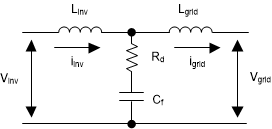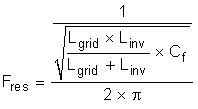TIDUE53I march 2018 – july 2023 TMS320F28P550SJ , TMS320F28P559SJ-Q1
- 1
- Description
- Resources
- Features
- Applications
- 6
- 1System Description
- 2System Overview
-
3Hardware, Software, Testing Requirements, and Test Results
- 3.1 Required Hardware and Software
- 3.2 Testing and Results
- 4Design Files
- 5Trademarks
- 6About the Authors
- 7Revision History
2.3.1.2 LCL Filter Design
Any system of power transfer to the grid is required to meet certain output specifications for harmonic content. In voltage sourced systems like modern photo-voltaic inverters, a high-order LCL filter typically provides sufficient harmonic attenuation, along with reducing the overall design size versus a simpler filter design. However, due to the higher order nature, take some care in its design to control resonance. Figure 2-31 shows a typical LCL filter.
 Figure 2-31 LCL Filter Architecture
Figure 2-31 LCL Filter ArchitectureOne of the key benefits of using SiC MOSFETs (as this reference design does) is the ability to increase the switching frequency of the power stage significantly versus traditional Si-based switching elements. This increased switching frequency has a direct impact on the inverter's output filter resonant design, which needs to be accounted for. To make sure that the filter is designed correctly around this switch frequency, this known mathematical model is used in this design.
The primary component is the inverter inductor, or Linv, which can be derived using Equation 49:

Using re-determined system specifications, one can easily calculate the primary inductor value:

The sizing of the primary filter capacitor is handled in a similar fashion using Equation 3:

Make some design assumptions to finalize the value of Cf , namely, limiting the total reactive power absorbed by the capacitor to 5%. Scaling the total system power by the per phase power results in a primary capacitor value of:



For the remainder of the filter design, determine the values by defining the attenuation factor between the allowable ripple in grid inductor and the inverter inductor. This factor needs to be minimized while still maintaining a stable and cost effective total filter. By assuming an attenuation factor, an r value, which defines the ratio between the two inductors, is determined using Equation 4:
To obtain an attenuation factor of 10%, and using the earlier derived values, the value of r can be evaluated to be:

The resultant value for Lgrid is then:

The filter design can be validated by determining its resonant frequency (Fres). A good criteria for providing a stable Fres is that it is an order of magnitude above the line frequency and less than half the switching frequency. This criteria avoids issues in the upper and lower harmonic spectrums. The resonant frequency of the filter is defined using Equation 9:

Or, using the derived filter values:

This value for Fres meets the criteria listed earlier and validates the filter design.
The remaining value to determine is the passive damping that must be added to avoid oscillation. Generally, a damping resistor at the same relative order of magnitude as the Cf impedance at resonance is suitable. This impedance is easily derived using Equation 11:


For the final implementation in hardware, use real values for all of these components based on product availability and must be chosen to be appropriately close (±10% typically). When final values are determined, recalculate the resonant frequency to make sure the filter is still stable.